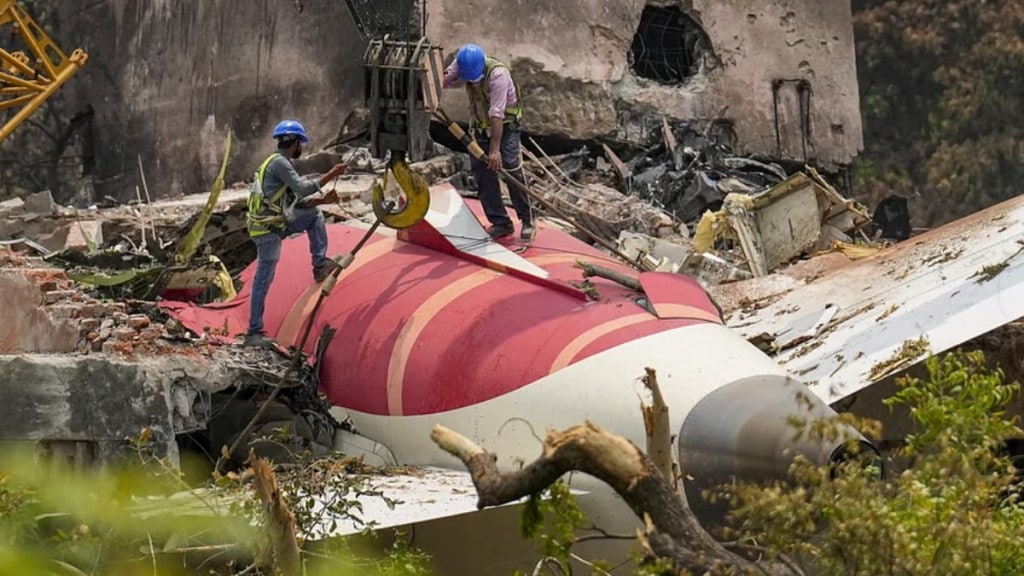A preliminary report into the June 12 crash of an Air India Dreamliner has found that the fuel supply to both engines was cut off moments after takeoff, plunging the plane back to the ground within 30 seconds.
The Boeing 787-8, operating as Flight AI171 from Ahmedabad to London, crashed into a medical college hostel just outside the airport perimeter, killing 241 of the 242 people on board and 19 on the ground. According to the 15-page preliminary investigation report released by the Aircraft Accident Investigation Bureau (AAIB) early morning on Saturday, both engine fuel switches were moved to the “cutoff” position within a second of each other immediately after takeoff, disabling the engines and depriving the aircraft of thrust.
However, the report has not established how or why the switches were flipped, a key question that is expected to be the focus of the continuing investigation. According to cockpit audio recordings, one pilot asked the other why the switches had been turned off, only to be told that he hadn’t done it.
About 10 seconds after the fuel supply was cut, the switches were moved back to the “run” position. The pilots attempted to restart both engines, and while one appeared to respond, the second engine failed to regain power. The plane continued to lose speed and height.
One of the pilots made a “Mayday, Mayday, Mayday” distress call, but before the air traffic controllers could get a response about what had gone wrong, the plane crashed. The time between takeoff and crash was just under half a minute.
The preliminary findings, which were based on data from the cockpit voice recorder, digital flight data recorder, wreckage site inspection, and fuel sample analysis, offer the first official insight into what led to the first total hull loss of a Boeing 787 Dreamliner.
The report did not say whether the switches were inadvertently or intentionally moved to the cutoff position. Moving the switches in-flight is extremely rare and usually done only in case of engine fire or serious malfunction. The switches are designed with a locking mechanism that makes accidental movement unlikely.
CCTV footage showed the aircraft’s ram air turbine (RAT), a backup hydraulic power source, had deployed just after takeoff, another indication of engine failure. At the time, first officer Clive Kunder, 32, was piloting the aircraft, while the senior captain, Sumeet Sabharwal, 56, was monitoring the flight. Kunder had logged over 1,100 hours on the 787 and 3,400 total flying hours. Sabharwal had 15,638 hours, including more than 8,500 on the 787, and was an instructor at Air India.
The AAIB report confirmed that both pilots had passed mandatory pre-flight breathalyser tests and were seen in normal condition in pre-boarding CCTV footage. There was no evidence of intoxication or foul play at this stage of the investigation. The crash occurred at 13:39 IST, just after the aircraft had taken off from Ahmedabad airport.
The report noted a 2018 US Federal Aviation Administration bulletin that warned of a potential disengagement of the locking feature on Boeing fuel control switches on both the 737 and 787 models. However, inspection for this fault was not mandatory, and Air India’s aircraft had not been checked for it. The AAIB said there had been no reported issues with the switch since 2023.
“The aircraft achieved the maximum recorded airspeed of 180 knots immediately after takeoff, and within seconds, both fuel cutoff switches transitioned from RUN to CUTOFF,” the report said. “The RAT deployment and rapid engine rollback were consistent with fuel supply loss.”
While the cockpit transcript revealed the brief exchange between the pilots about the switches, there was little other insight into cockpit interaction or coordination, and the report did not offer a timeline of individual pilot actions. The AAIB said it was still reviewing data downloaded from the enhanced flight recorder and would continue gathering evidence, including interviews, forensic testing, and component analysis.
The aircraft, powered by GE GEnx-1B engines, had been recently maintained and fuel samples from bowsers and tanks used for refueling were found satisfactory. Investigators said both engines were retrieved from the crash site and stored in a hangar for further examination.
Air India issued a statement expressing its condolences. “We stand in solidarity with the families and those affected by this tragic event and continue to mourn the loss. We are fully cooperating with the authorities and will support the investigation in every possible way,” it said.
Acknowledging the report, Boeing, in a statement said, “Our thoughts remain with the loved ones of the passengers and crew on board Air India Flight 171, as well as everyone affected on the ground in Ahmedabad. We continue to support the investigation and our customers.”
The US National Transportation Safety Board (NTSB) and the UK’s Air Accident Investigation Branch are assisting the authorities. The NTSB declined to comment, directing all inquiries to the AAIB.
According to the AAIB, the crash site had been documented with drone imaging and the wreckage moved to a secure location. Fuel residues were recovered in very limited quantities from the auxiliary power unit and wing valves and will be sent for further testing.
Witness statements and the account of the sole survivor, have also been recorded.
The AAIB said that a final determination on the cause of the crash will take months. For now, it has recommended no changes for operators of Boeing 787-8 aircraft or GE GEnx-1B engines, pending further findings.

